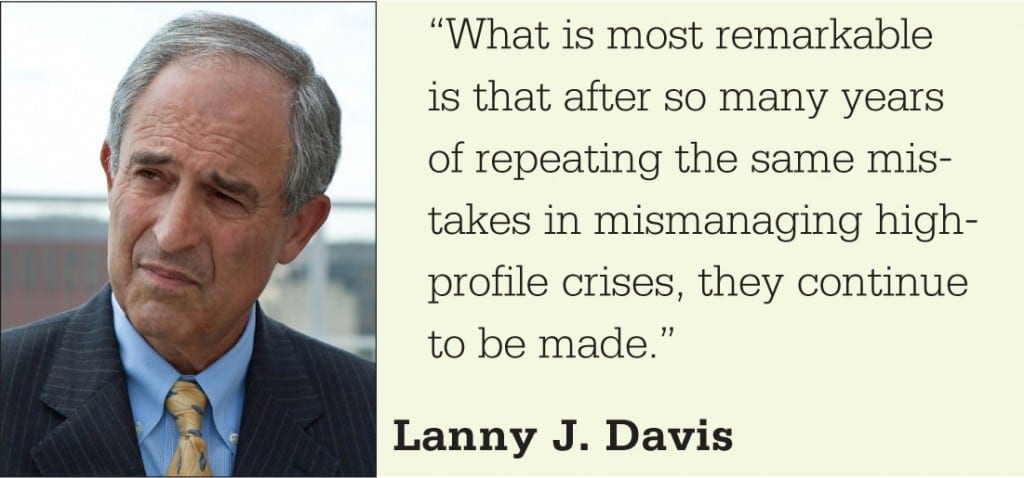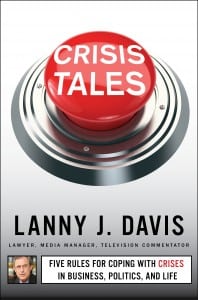[Editor’s Note: Lanny Davis knows a thing or two about PR crises. He had a few in his time as a White House special counsel for President Bill Clinton from 1996 to 1998. Clinton, for those who remember, had his share of PR challenges during those years. Today, Davis heads public affairs agency Purple Nations Solutions . The following excerpt is from Davis’ new book, “Crisis Tales: Five Rules for Coping With Crises in Business, Politics, and Life.” ]
More than a quarter century ago, the Nixon crisis managers in the Watergate scandal made all the fundamental mistakes that make a bad crisis worse: deny, deny, deny; then the “limited modified hang-out” of partial disclosure, then the cover-up; and finally, after the inevitable dribble, dribble, dribble of facts leading to critical mass and the final explosion, the resignation of a president of the United States.
The crisis management mistakes made in Watergate have been repeated in the corporate arena—from the mismanagement of the media and message after the Exxon Valdez oil tanker grounded on a sandbar, beginning a massive oil leak that soiled Alaskan shorelines and wildlife, to the difficulties experienced by BP during and after the Deepwater Horizon oil spill. What is most remarkable is that after so many years of repeating the same mistakes in mismanaging high-profile crises, they continue to be made—denial, delay in getting the facts out, letting the legal concerns trump the brand and media perceptions, and then watching helplessly as the truth inevitably dribbles out in Chinese-water-torture fashion—as if no one has any memory, or has learned anything from the past. There are plenty of examples of this amnesia and blindness to the fundamental rules of crisis management in recent years, through 2012. For example:
• During the 2011 Republican contest for the presidential nomination, former Republican presidential candidate Herman Cain seemed to believe that he could ride out the specific allegations made public by individuals that he had engaged in sexual harassment and personal indiscretions and that the media would lose interest if he just nailed down the hatches and ducked for cover. Of course, as inevitably as the sun rising in the east, several more shoes dropped—and it was Mr. Cain’s presidential campaign, not the story, that died relatively quickly.
• Another example in 2011 and through 2012 was the Obama White House’s handling of the issue of the Solyndra government-guaranteed loan, which ended up in an embarrassing bankruptcy after being touted by the Obama White House as a great success story (and one pushed by the White House for media events, including one involving the president personally). But we saw the common pattern when bad stories arise, whether in the White House or corporate suites—first the White House resisted turning over emails and other documents to the Republican oversight committee. Was anyone surprised that sooner or later these emails actually leaked and most had to be turned over, after all was said and done? Shocking! Then the White House press office referred most questions to the Energy Department. Was anyone surprised that doing so left the impression that the White House seemed to be hiding something?
I am sure, in hindsight, that the White House press office realized that they would have been better off doing what we at the Clinton White House called a “document dump”—collect all the emails and documents, put them on a conference room table, invite in all the reporters, and stand there and answer all nasty questions and refuse to leave until everyone was done, and then the story can be over with.
• In late 2011 and early 2012 there was the mishandling of the decision by the leaders of the Susan G. Komen for the Cure foundation to cut off funding for Planned Parenthood. The Komen leaders initially were evasive about acknowledging that the decision had anything to do with politics. The first explanation was that the funding was cut off pending the results of an “investigation” announced by Florida Republican congressman Cliff Stearns. (This was the same Representative Stearns who was subsequently defeated in an August 2012 Republican primary when he sought reelection. His so-called investigation ultimately went nowhere.) Then the public subsequently learned from the media that a senior official of Komen, Karen Handel, was part of the decision-making process that led to the funding cutoff. And that the same Ms. Handel, an anti-abortion, “prolife” advocate, had stated during her unsuccessful campaign for Georgia governor: “Since I am prolife, I do not support the mission of Planned Parent-hood.”
Would it not have been better crisis management— “tell it all, tell it early... etc.”—for Komen to disclose immediately that Ms. Handel, with a known anti-abortion, anti–Planned Parenthood history, was at least involved in the decision to cut off Planned Parenthood funding by the Komen Foundation?
• The 2012 Romney campaign failed for many reasons, but two of the major mishandled crises that might have affected the outcome were the failure to publish prior tax returns way before the 2012 campaign heated up—even before the 2011 Republican nomination contests; and second, Governor Romney’s failure to step up to the line— “get in front of the story”—when he was caught on a cell phone camera at a private fund-raiser commenting, in effect, that 47% of the electorate were for President Obama and wouldn’t change their minds because they were dependent upon government to sustain them. Romney’s strategy was to describe his comments as “in-elegantly expressed”—and that only caused the story to blow up on him more, since it seemed to confirm that he really meant what he said, but he just it expressed it badly.
On the other hand, I would have advised him— assuming he would have believed these words—to say, simply: “You know, that was a stupid mistake and I didn’t mean it—of course those 47% are composed of voters who have many reasons for not being for me not relating to government, and I want to apologize to them.”
I am convinced that the 47% issue would have gone away had he said this or something similar. After all, there were plenty of examples of President Obama making gaffes behind closed doors (such as his famous “they get bitter, and they cling to guns,” during the Democratic nomination race in 2008; or Senator Biden implying that Republicans favor keeping people in “chains”).
Gaffes can be excused—Americans are a forgiving lot. But it requires an authentic admission, “I screwed up”— and let’s move on.
So, in short, my advice to Mr. Romney—as well as to Vice President Biden and any other politician who makes an embarrassing gaffe—is what I should have told myself when I found myself the subject of a negative story before I was ready, is to “Tell it all, tell it early, tell it yourself.” PRN
From “Crisis Tales: Five Rules for Coping with Crises in Business, Politics, and Life” by Lanny J. Davis. Copyright 2013 by Lanny J. Davis. Reprinted by permission of Threshold Editions, an imprint of Simon & Schuster, Inc.


